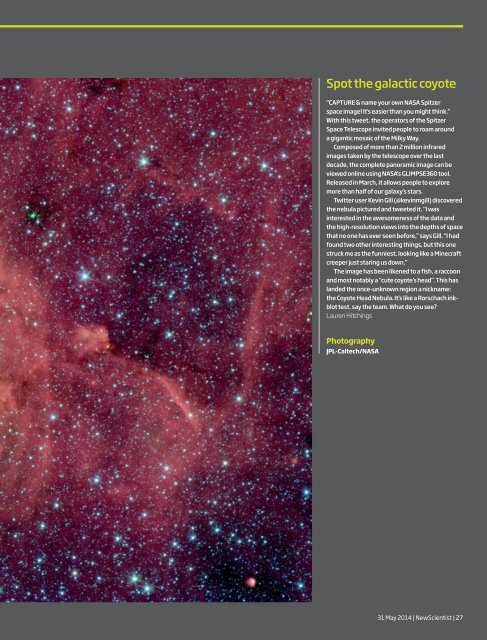New Scientist - 31 May 2014.bak
New Scientist - 31 May 2014.bak
New Scientist - 31 May 2014.bak
Create successful ePaper yourself
Turn your PDF publications into a flip-book with our unique Google optimized e-Paper software.
Spot the galactic coyote<br />
“CAPTURE & name your own NASA Spitzer<br />
space image! It’s easier than you might think.”<br />
With this tweet, the operators of the Spitzer<br />
Space Telescope invited people to roam around<br />
a gigantic mosaic of the Milky Way.<br />
Composed of more than 2 million infrared<br />
images taken by the telescope over the last<br />
decade, the complete panoramic image can be<br />
viewed online using NASA’s GLIMPSE360 tool.<br />
Released in March, it allows people to explore<br />
more than half of our galaxy’s stars.<br />
Twitter user Kevin Gill (@kevinmgill) discovered<br />
the nebula pictured and tweeted it. “I was<br />
interested in the awesomeness of the data and<br />
the high-resolution views into the depths of space<br />
that no one has ever seen before,” says Gill. “I had<br />
found two other interesting things, but this one<br />
struck me as the funniest, looking like a Minecraft<br />
creeper just staring us down.”<br />
The image has been likened to a fish, a raccoon<br />
and most notably a “cute coyote’s head”. This has<br />
landed the once-unknown region a nickname:<br />
the Coyote Head Nebula. It’s like a Rorschach inkblot<br />
test, say the team. What do you see<br />
Lauren Hitchings<br />
Photography<br />
JPL-Caltech/NASA<br />
<strong>31</strong> <strong>May</strong> 2014 | <strong>New</strong><strong>Scientist</strong> | 27


